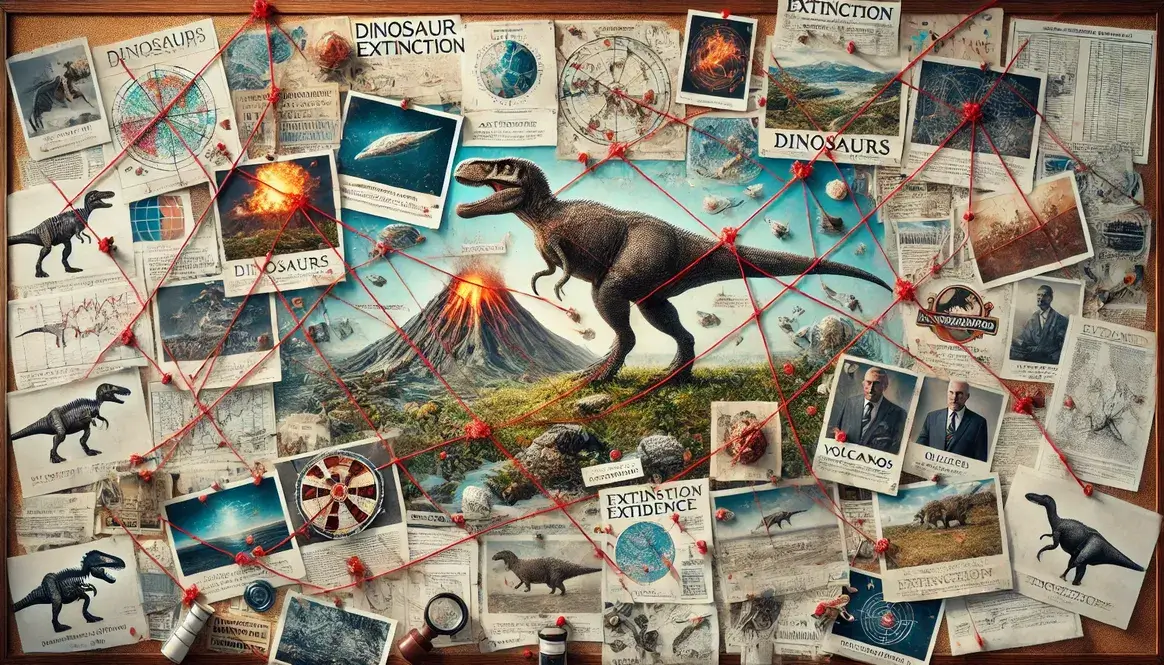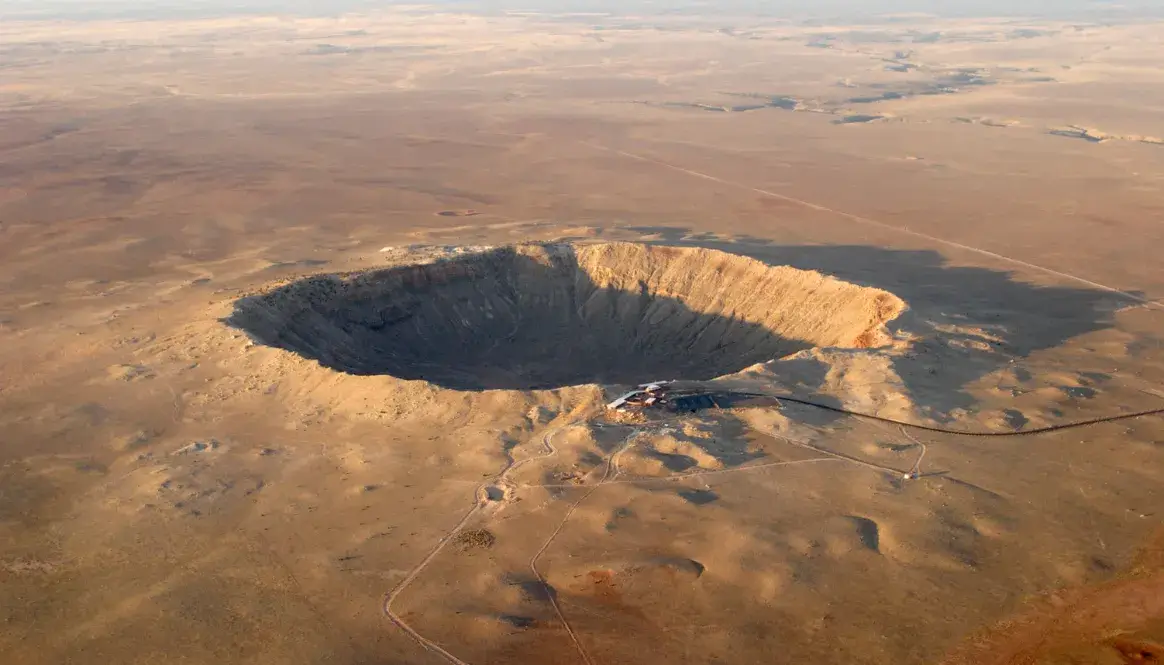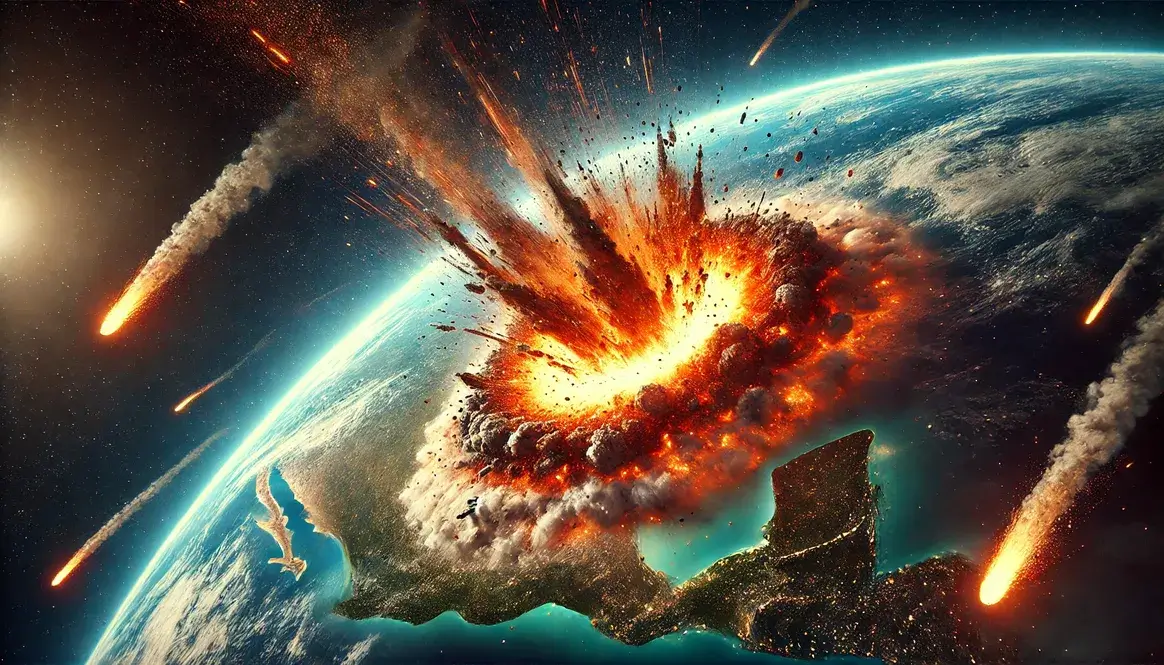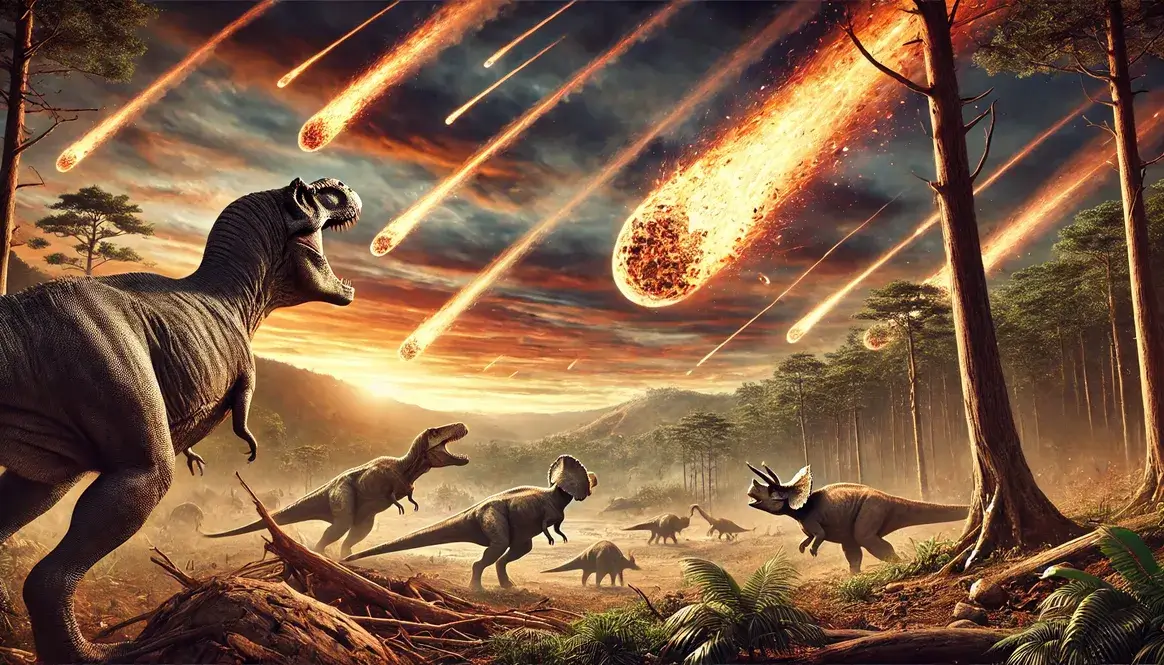About 66 million years ago, a catastrophic event changed life on Earth forever. This moment in time, known as the Cretaceous-Paleogene (K-Pg) extinction, saw the disappearance of roughly 75% of plant and animal species on our planet. Most famously, it marked the end of the non-avian dinosaurs’ reign.
This mass extinction has puzzled scientists for decades, sparking a lively debate over what killed the dinosaurs. As researchers dig deeper into Earth’s past, they’ve unearthed clues that have led to several competing theories.
Two main ideas have emerged as the frontrunners in this scientific discussion:
- The Asteroid Impact Hypothesis: This theory suggests that a massive space rock slammed into Earth, causing worldwide devastation.
- The Volcanic Activity Hypothesis: Another group of scientists argues that enormous volcanic eruptions led to long-term climate changes that doomed the dinosaurs.
But the debate doesn’t stop there. Some researchers propose that it wasn’t just one thing that spelled doom for the dinosaurs, but a combination of factors. They believe that multiple events might have worked together, creating a “perfect storm” that changed life on Earth dramatically.
As we explore these theories, we’ll look at the evidence supporting each idea and the questions that still remain. The debate over what killed the dinosaurs is more than just a scientific squabble – it’s a fascinating journey into Earth’s past that helps us understand how our planet’s history shapes its future.
The Asteroid Impact Hypothesis
The idea that a massive space rock crashed into Earth, causing widespread destruction, has captured the imagination of many scientists and the public alike. This theory suggests that the impact was so powerful it led to global climate changes that the dinosaurs couldn’t survive.
Evidence Supporting the Impact Theory
Scientists have found several compelling clues that point to a massive asteroid impact:
- Iridium layer: A thin layer of iridium, an element rare on Earth but common in asteroids, was found worldwide at the boundary between the Cretaceous and Paleogene periods (K-Pg boundary). This discovery, made by father-son team Luis and Walter Alvarez, kickstarted the impact theory.
- Chicxulub crater: The Chicxulub crater discovery in Mexico’s Yucatan Peninsula provides physical evidence of a massive impact. This enormous crater, measuring about 180 kilometers in diameter, dates back to the time of the dinosaur extinction.
- Global debris: Scientists have found tiny spheres of rock and other impact-related materials spread across the globe, supporting the idea of a worldwide catastrophe.
The power of the Chicxulub impact was truly staggering. Researchers estimate that the asteroid was about 10 to 15 kilometers wide and hit Earth with the force of several million nuclear bombs. This immense energy release would have had devastating immediate and long-term effects:
- Massive tsunamis scouring coastlines
- Widespread fires ignited by the heat of impact debris
- A prolonged “impact winter” caused by dust and aerosols blocking sunlight
Arguments Against the Impact Theory
Despite strong evidence, some scientists question whether an asteroid impact alone could have caused such widespread extinction:
Timing questions: Some researchers argue that the impact might have occurred before or after the main extinction event. They point to fossil evidence suggesting that dinosaur populations were already declining before the K-Pg boundary.
Impact effects debate: There’s disagreement about whether an impact of this size could cause global, long-lasting climate effects. Some scientists argue that Earth’s systems might have recovered more quickly than the impact theory suggests.
Alternative explanations: Some researchers propose that the impact-related evidence could have other causes:
- Volcanic activity might have released iridium from Earth’s mantle
- Multiple smaller impacts could have created the global debris layer
- Other geological processes might explain some of the evidence attributed to a single large impact
While the asteroid impact hypothesis remains the leading theory in the debate over what killed the dinosaurs, these questions keep the scientific discussion lively and ongoing. As researchers continue to study this ancient mystery, they uncover new clues that help us better understand one of the most significant events in Earth’s history.
The Volcanic Activity Hypothesis
While the asteroid impact theory has garnered significant attention, another major contender in the debate over what killed the dinosaurs focuses on massive volcanic eruptions. This hypothesis suggests that long-lasting volcanic activity caused significant climate changes that led to the extinction of dinosaurs and many other species.
Evidence for Volcanic Causes
Deccan Traps eruptions and their timing
The Deccan Traps in India play a central role in this theory. These enormous lava flows covered an area larger than France and were active around the time of the dinosaur extinction. The timing of these eruptions is crucial to the volcanic hypothesis:
- Began erupting approximately 66 million years ago
- Peak activity coincided with the K-Pg extinction event
- Continued for several hundred thousand years
Effects of prolonged volcanic activity on climate
Volcanic eruptions on this scale could have had profound effects on global climate:
- Cooling: Ash and sulfur dioxide released into the atmosphere could have blocked sunlight, leading to global cooling.
- Warming: Large amounts of carbon dioxide from the eruptions might have caused long-term warming through the greenhouse effect.
- Acid rain: Sulfur emissions could have led to widespread acid rain, damaging plant life and disrupting food chains.
Geological evidence for increased volcanism
Scientists have found several lines of evidence supporting increased volcanic activity during this period:
- Thick layers of lava flows in the Deccan Traps region
- Elevated levels of mercury in sediments worldwide, often associated with volcanic activity
- Changes in the composition of marine sediments indicating shifts in ocean chemistry
Challenges to the Volcanic Theory
Despite compelling evidence, the volcanic hypothesis faces several challenges in explaining the dinosaur extinction.
Questions about the scale of volcanic effects
While the Deccan Traps eruptions were undoubtedly massive, some scientists argue that even this level of volcanism might not be enough to cause a global mass extinction. They point out that:
- Earth has experienced other large igneous province eruptions without causing extinctions on the scale of the K-Pg event.
- The effects of volcanism might be more regional than global.
Timing issues with volcanic activity
The timing of the Deccan Traps eruptions in relation to the extinction event is still debated:
- Some studies suggest that the most intense volcanic activity occurred after the main extinction pulse.
- There’s uncertainty about how quickly volcanic effects would have impacted global ecosystems.
Comparison with other major volcanic events
When looking at Earth’s history, scientists have found that other major volcanic events didn’t always lead to mass extinctions. This raises questions about why the Deccan Traps eruptions would have been uniquely devastating.
| Volcanic Event | Age (Million Years Ago) | Associated Extinction? |
|---|---|---|
| Deccan Traps | 66 | Yes (K-Pg) |
| Siberian Traps | 252 | Yes (End-Permian) |
| Central Atlantic Magmatic Province | 201 | Yes (End-Triassic) |
| Columbia River Basalts | 16 | No major extinction |
While the volcanic activity hypothesis provides a compelling alternative in the debate over what killed the dinosaurs, it also highlights the complexity of Earth’s systems and the challenges in understanding events from millions of years ago. As research continues, scientists are working to piece together how volcanic activity might have interacted with other factors to shape the course of life on Earth.
The Multiple Cause Hypothesis
As the debate over what killed the dinosaurs continues, some scientists propose that it wasn’t just one thing, but a combination of factors that led to the extinction. This “perfect storm” scenario suggests that multiple events worked together to create conditions that were too extreme for many species to survive.
Combining Asteroid Impact and Volcanism
The idea of combining the asteroid impact and volcanic activity theories has gained traction among many researchers. This “one-two punch” hypothesis proposes that these major events might have worked together to cause the mass extinction.
Synergistic effects of multiple events
When considering how an asteroid impact and volcanic eruptions might have interacted, scientists have identified several potential synergistic effects:
- Impact-triggered volcanism: The shock of the asteroid impact might have intensified volcanic activity in the Deccan Traps.
- Cumulative atmospheric changes: Dust and gases from both events could have amplified climate effects.
- Weakened ecosystems: Stress from one event might have made species more vulnerable to the effects of the other.
How different factors might have interacted
The interaction between an asteroid impact and volcanic activity could have created a cascade of environmental changes:
- Global cooling from impact dust and volcanic ash blocking sunlight
- Subsequent warming due to greenhouse gases from both events
- Ocean acidification from dissolved gases
- Disrupted food chains due to plant die-offs
These combined effects might explain the severity and global nature of the extinction event better than either theory alone.
Support for a “one-two punch” scenario
Recent research has provided evidence supporting this combined approach:
- Studies of the timing of Deccan Traps eruptions show increased activity around the time of the impact.
- Simulations of the Chicxulub impact have shown how it could have triggered increased global volcanism.
- Analysis of climate proxies suggests rapid temperature fluctuations consistent with multiple causes.
Other Contributing Factors
While the asteroid impact and volcanism are often the focus of the debate, other factors might have played a role in the extinction event.
Climate change and sea level fluctuations
Even before the main extinction event, Earth was experiencing significant environmental changes:
- Cooling trends in the late Cretaceous period
- Fluctuating sea levels affecting coastal habitats
- Changes in ocean circulation patterns
These ongoing changes might have already stressed many species, making them more vulnerable to sudden catastrophic events.
Changes in plant communities
The late Cretaceous saw significant shifts in plant life, which could have impacted dinosaur populations:
- Decline of certain plant groups that some dinosaurs relied on for food
- Spread of flowering plants changing ecosystem dynamics
- Potential changes in plant toxicity or nutritional value
Potential role of diseases or other stressors
Some researchers have suggested that other factors might have contributed to the extinction:
- Diseases: Stressed populations might have been more susceptible to pathogens.
- Competition: Changing ecosystems might have altered competitive relationships between species.
- Cosmic radiation: Some theories propose increased exposure to cosmic rays might have played a role.
While these factors are harder to find evidence for in the fossil record, they remind us of the complex interplay of forces that shape life on Earth.
By considering multiple causes, scientists hope to build a more complete picture of the events that led to the extinction of the dinosaurs. This approach highlights the interconnected nature of Earth’s systems and the complexity of studying events from millions of years ago.
Key Points of Contention in the Debate
The debate over what killed the dinosaurs involves several areas where scientists disagree. These points of contention drive ongoing research and discussions in the scientific community.
Timing and Duration of Extinction
One major point of discussion is how quickly the extinction happened. Scientists are divided between two main viewpoints:
- Gradual extinction: Some researchers argue that dinosaur diversity was already declining before the major extinction event.
- Sudden extinction: Others believe the extinction was rapid, happening over a relatively short geological timespan.
Evidence from the fossil record
The fossil record provides crucial evidence in this debate, but it’s not always straightforward to interpret:
- Some locations show a sharp decline in fossil diversity at the K-Pg boundary.
- Other sites suggest a more gradual decrease in species over time.
- Preservation biases can make it difficult to determine exact extinction patterns.
Challenges in precise dating of events
Dating events from millions of years ago presents several challenges:
- Radiometric dating techniques have margins of error that can span thousands of years.
- Sediment mixing can blur the lines between different time periods.
- The K-Pg boundary’s exact location can be difficult to pinpoint in some areas.
These challenges make it hard to determine the precise sequence and timing of events around the extinction, fueling ongoing debates.
Global vs. Regional Effects
Another key area of contention is how the extinction affected different parts of the world. This aspect of the debate has significant implications for understanding the nature and causes of the extinction event.
Variations in extinction patterns across the globe
Research has shown that the K-Pg extinction didn’t affect all regions equally:
- Some areas show evidence of rapid, severe extinctions.
- Other locations suggest more gradual changes or even survivorship of certain species.
This variability has led to debates about the true global nature of the extinction event and its causes.
Local survival and extinction hotspots
Scientists have identified several areas where dinosaurs and other species might have survived longer after the main extinction event:
- Isolated islands
- High-altitude regions
- Freshwater environments
These potential “refugia” complicate our understanding of the extinction process and challenge simple, single-cause explanations.
Implications for different extinction theories
The regional variations in extinction patterns have different implications for the main extinction theories:
| Theory | Supported by Regional Variations | Challenged by Regional Variations |
|---|---|---|
| Asteroid Impact | Global iridium layer | Uneven extinction patterns |
| Volcanism | Varying effects based on proximity | Lack of clear correlation with Deccan Traps |
| Multiple Causes | Explains complex patterns | Difficult to model all interactions |
Understanding these regional differences is crucial for developing a comprehensive explanation of the extinction event. It highlights the complexity of Earth’s systems and the challenges in studying events from the distant past.
As research continues, scientists are working to reconcile these regional variations with broader theories about what killed the dinosaurs. This ongoing debate drives new discoveries and deepens our understanding of Earth’s history and the nature of mass extinctions.
Current Scientific Consensus
While the debate over what killed the dinosaurs continues, a general consensus has emerged among many scientists. The majority of researchers now support a combination of factors, with the asteroid impact playing a central role.
The Alvarez impact hypothesis, which first proposed the impact theory, has gained significant support over the years. Most scientists agree that a large asteroid did strike Earth around 66 million years ago, causing widespread devastation. However, many researchers also recognize the potential contribution of other factors, such as volcanic activity and pre-existing environmental stresses.
Areas of ongoing research and debate
Despite the growing consensus, several areas remain hotly debated:
- The relative importance of impact vs. volcanic effects
- The duration and pattern of the extinction event
- The role of pre-existing environmental conditions
- The nature of species recovery after the extinction
These ongoing discussions drive new research and discoveries. Scientists continue to refine their methods for studying ancient climates, ecosystems, and geological events. New technologies, such as advanced computer modeling and high-resolution chemical analysis, are providing fresh insights into this ancient mystery.
Importance of continued study and new discoveries
The debate over what killed the dinosaurs is far from over. Each new discovery has the potential to reshape our understanding of this crucial moment in Earth’s history. For example, recent findings about the Chicxulub impact’s power have helped scientists better understand its immediate and long-term effects.
Continued research into the K-Pg extinction event is important for several reasons:
- It helps us understand how Earth’s systems respond to major disturbances
- It provides insights into the evolution and resilience of life
- It offers lessons that may be relevant to current and future environmental challenges
As we delve deeper into Earth’s past, we not only learn about ancient events but also gain valuable perspectives on our planet’s present and future.
Lessons from the Dinosaur Extinction Debate
The ongoing discussion about the fate of dinosaurs teaches us important lessons that extend far beyond paleontology.
Implications for understanding mass extinctions
The study of the K-Pg extinction event has broad implications for our understanding of mass extinctions in general:
- Multiple factors often contribute to major extinction events
- The effects of global catastrophes can vary by region and ecosystem
- Some species are more vulnerable to extinction than others
These insights help scientists interpret other extinction events in Earth’s history and may even help predict future ecological risks.
Relevance to current climate and biodiversity issues
The debate over what killed the dinosaurs has surprising relevance to modern environmental concerns:
- It demonstrates how rapidly Earth’s climate can change under extreme circumstances
- It shows the interconnectedness of Earth’s systems (atmosphere, oceans, land)
- It highlights the potential for cascading effects in ecosystems
Understanding past extinctions can inform our approach to current biodiversity loss and climate change. While the circumstances are different, the underlying principles of ecosystem resilience and environmental tipping points remain relevant.
Importance of multidisciplinary approaches in science
Perhaps one of the most valuable lessons from this debate is the importance of multidisciplinary research. The study of dinosaur extinction brings together experts from various fields:
- Paleontology
- Geology
- Climate science
- Biology
- Chemistry
- Physics
This collaborative approach has led to more comprehensive theories and a deeper understanding of complex Earth systems. It serves as a model for tackling other big scientific questions, showing how diverse perspectives can lead to more robust and nuanced understanding.
In conclusion, the debate over what killed the dinosaurs is more than just a scientific curiosity. It’s a window into Earth’s past that offers valuable lessons for the present and future. As research continues, each new discovery adds another piece to this fascinating puzzle, enriching our understanding of life’s history on our planet.









